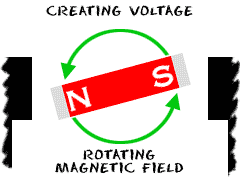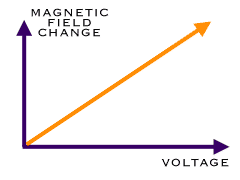Faraday Basics
 Faraday's law of induction is one of the important concepts of
electricity. It looks at the way changing magnetic fields can cause
current to flow in wires. Basically, it is a formula/concept that
describes how potential difference (voltage difference)
is created and how much is created. It's a huge concept to understand
that the changing of a magnetic field can create voltage.
Faraday's law of induction is one of the important concepts of
electricity. It looks at the way changing magnetic fields can cause
current to flow in wires. Basically, it is a formula/concept that
describes how potential difference (voltage difference)
is created and how much is created. It's a huge concept to understand
that the changing of a magnetic field can create voltage.
Faraday's Work
Michael Faraday was an English physicist working in the early 1800's. He worked with another scientist named Sir Humphrey Davy. Faraday's big discovery happened in 1831 when he found that when you change a magnetic field, you can create an electric current. He did a lot of other work with electricity such as making generators and experimenting with electrochemistry and electrolysis.Faraday's experiments started with magnetic fields that stayed the same. That setup did not induce current. It was only when he started to change the magnetic fields that the current and voltage were induced (created). He discovered that the changes in the magnetic field and the size of the field were related to the amount of current created. Scientists also use the term magnetic flux. Magnetic flux is a value that is the strength of the magnetic field multiplied by the surface area of the device.
Faraday's Law
You're going to have to review your Greek letters when you memorize the real formula. Here are the basics...
E=dB/dt
 "E" is the value of voltage induced (the old name for
voltage was "ElectroMotive Force", or EMF. That's the "E" in the
equation). The change in time for the experiment is "dt". Time is
measured in seconds. Last is "dB" which stands for the change in
magnetic flux. The magnetic flux is the field lines of the magnetic
field. The flux is equal to BA, where B is the magnetic field strength,
and A is the area. This formula is a bit harder than those you may have
seen before.
"E" is the value of voltage induced (the old name for
voltage was "ElectroMotive Force", or EMF. That's the "E" in the
equation). The change in time for the experiment is "dt". Time is
measured in seconds. Last is "dB" which stands for the change in
magnetic flux. The magnetic flux is the field lines of the magnetic
field. The flux is equal to BA, where B is the magnetic field strength,
and A is the area. This formula is a bit harder than those you may have
seen before.
In English: the amount of voltage created is equal to the change in magnetic flux divided by the change in time. The bigger the change you have in the magnetic field, the greater amount of voltage.